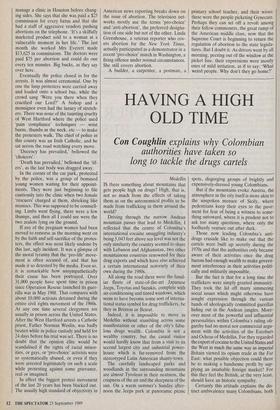HAVING A HIGH OLD TIME
Con Coughlin explains why Colombian
authorities have taken so long to tackle the drugs cartels
Medellin IS there something about mountains that gets people high on drugs? High, that is, not so much from the effects of taking them as on the astronomical profits to be made from trafficking in them around the world?
Driving through the narrow Andean mountain passes that lead to Medellin, I reflected that the centre of Colombia's international cocaine smuggling industry's being 5,043 feet above sea level was not the only similarity the country seemed to share with Lebanon and Afghanistan, two other mountainous countries renowned for their drug exports and which have also achieved a certain international notoriety of their own during the 1980s.
All along the road there were the famil- iar fleets of state-of-the-art Japanese Jeeps, Toyotas and Suzukis, complete with air-conditioning and tinted windows, which seem to have become some sort of interna- tional status symbol for drug traffickers, be they in Brixton or Beirut.
Indeed, it is impossible to move in Medellin without stumbling across some manifestation or other of the city's fabu- lous drugs wealth. Colombia is not a wealthy country, but the casual visitor would hardly know that from a visit to its second largest city and industrial power- house which is far-removed from the stereotyped Latin American shanty-town.
The carefully landscaped parks and woodlands in the surrounding mountains are almost Tyrolean in their neatness, the crispness of the air and the sharpness of the sun. On a warm summer's Sunday after- noon the Jeeps park at panoramic picnic spots, disgorging groups of brightly and expensively-dressed young Colombians.
But if the mountains evoke Austria, the atmosphere in the city itself is more akin to the unspoken menace of Sicily, where pedestrians keep their eyes to the pave- ment for fear of being a witness to some- thing untoward, where it is prudent not to ask too many questions, where only the foolhardy venture out after dark.
Those now leading Colombia's anti- drugs crusade like to make out that the cartels were built up secretly during the 1970s and that the authorities only became aware of their activities once the drug barons had enough wealth to make govern- ment interference in their activities politi- cally and militarily impossible.
But the fact is that for a long time the traffickers were simply granted immunity. They took the lid off many simmering social issues which might otherwise have sought expression through the various bands of ideologically committed guerillas hiding out in the Andean jungles. More- over most of the powerful and influential personalities within Colombia's ruling oli- garchy had no moral nor commercial argu- ment with the activities of the Escobars and Ochoas of Medellin. For they regarded the export of cocaine to the United States and the West in much the same way as imperial Britain viewed its opium trade in the Far East: what possible objection could there be to making a handsome profit by sup- plying an insatiable foreign market? For this they feel the British, at the very least, should have an historic sympathy.
Certainly this attitude explains the dis- tinct ambivalence many Colombians, both Within and outside the ruling oligarchy, now feel towards President Bush's new drugs policy. No one has enjoyed the deadly cycle of murders against judges, Politicians, policemen and anyone else who has got in the cartel's way, and the current Tate of bombings and assassinations has instilled genuine fear. But given Col- ombia's violent past, the 8,000 cartel- Instigated murders of the past decade are
small fry. Between 1830 and 1903 Col- ombia suffered 23 civil wars which claimed one-twentieth of the population, an im- pressive record even for Latin America. Between 1948 and 1953 more than 300,000 died during La Violencia.
To provoke the cartels into open war- fare, as the current crackdown seems likely to do, runs the risk of initiating further bloodletting. Even with the aid from the United States and Europe that President 13arco is banking on receiving to keep the crusade alive, the cartels are so deeply en- trenched as to be well beyond the resources of the local authorities.
So why, after so many years, have the Colombians chosen this moment to find the political will, not to mention the Personal courage, to take on the cartels? The crucial factor for the authorities in Bogota is that the cartels simply got too big. It is not so much the demonstration of fabulous wealth (the scores of luxury apart- ments, farms, mansions, limousines and aircraft) that disturbed the government as the way the cartels were starting to take over the country. If the Colombian govern- ment didn't act now, there wouldn't be a government to act.
On conservative estimates the cartels now own 60 per cent of all Colombia's arable land, a staggering statistic. Recent- ly, as international moves to frustrate their Operations have intensified, the cartels have sought to invest in legitimate Col- ombian business, a development which has met with much resistance and bloodshed.
When Los Narcos attempted to buy into
Colombia's banana industry, they were Opposed by the union of banana workers. Enraged, the drugs mafia last December attacked a banana plantation in Urabar and hacked 41 workers to death. Forty-two workers at the Segovia gold mines met a similar fate after the cartels, investment approach was again rejected.
Whatever its limitations, Colombia has never been a banana republic and has no intention of becoming one now. The car- tels' solution to the drugs crisis is for the government to concede jurisdiction over large tracts of land in central Colombia to be administered wholly and independently by the drug warlords. On that basis the authorities in Bogota are not so much Committed to an international anti-drugs crusade as to the survival of Colombia as a national entity.
Con Coughlin writes for The Sunday Tele- graph.



























































 Previous page
Previous page